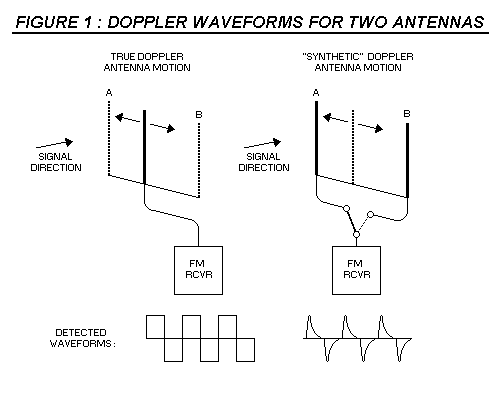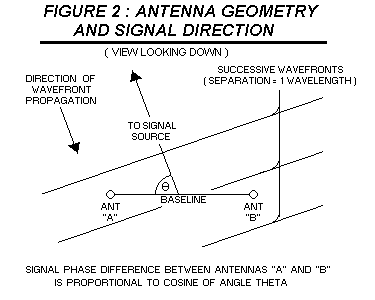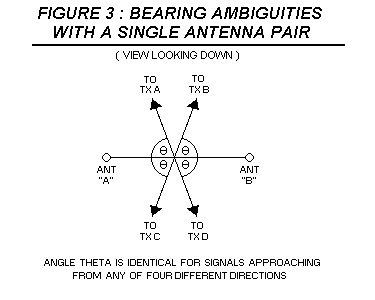DOPPLER PULSE PRINCIPLES
This section provides several insights about Doppler pulses... Their amplitude,
polarity, shape and duration, and how these quantities are affected by signal direction,
antenna spacing, and receiver passband characteristics. The next page ( INTEGRATION )
also provides some tips on the best methods for processing Doppler pulses, to extract the most
meaningful information from them.
BACKGROUND
Doppler shift is a change, or "shift", of ( recieved ) signal frequency
caused by relative motion between a signal source and a signal detector. The
classic example of Doppler shift involves the change of acoustic pitch for a
train whistle, ( or automobile horn ) as the train/auto passes by a stationary
observer.
Positive ( "approaching" ) Doppler shift causes the recieved frequency to be
greater than the "rest" frequency, and occurs whenever the source and detector
are approaching each other. Negative ( "receeding" ) Doppler shift causes the
recieved signal frequency to be lower than the "rest" frequency, and occurs
whenever the source and detector are receeding from each other.
The amount of Doppler shift ( expressed in Hertz ) is proportional to the
"rest" carrier frequency, and the relative velocity between the source and
detector. If the velocity units are expressed in terms of (signal) "wavelengths per
second", the resulting Doppler shift equates directly, because the two quantities
are numerically equal : A transmitting and recieving antenna which are
approaching each other at a rate of 500 "wavelengths per second" will cause +500
hertz of Doppler shift.
AN EXAMPLE
The rudiments of all Doppler D/F’s can be demonstrated with two antennas, as
shown below. Switching between two stationary antennas simulates the
action of a single, "hypothetical" antenna, which moves back and forth between
the locations occupied by the stationary antennas.
If this hypothetical antenna could be moved with constant velocity, the resulting
Doppler shift would be ( FM ) detected as a "square wave" signal... the positive half -
cycles of the square wave would occur as the antenna "approaches" the signal
source, and the negative half - cycles would occur as the antenna "receeds" from
the signal source.

Switching between stationary antennas does not simulate constant velocity, but it
does ( otherwise ) simulate antenna "motion". Because the hypothetical antenna
"suddenly" moves between the two locations, the resulting Doppler shift is equally
"sudden", resulting in Doppler "pulses". In this ( two antenna ) example, the
Doppler pulses consist of alternating positive and negative pulse polarities :
Positive pulses are produced by the antenna "nearest to" the signal source, and
negative pulses are produced by the antenna "farthest from" the signal source.
The Doppler pulses are caused by phase differences between the two antenna signals,
as shown below. signals from antenna "B" will
have a slight phase "delay" compared to signals from antenna "A".
This is simply due to the fact that antenna "B" is farther from the signal source than antenna "A", so
signals will require a slightly greater time to arrive at antenna "B". If antenna "A" is
closer to the source by 1/4 wavelength, the phase difference will be 90 degrees.

If the input of an FM receiver is switched between the two antennas, the various
resonant circuits in the receiver’s R/F and I/F amplifiers will be forced to “adjust”
to the change of RF signal phase, because these signals are derived from the RF
signal. The total amount of phase change in the amplifiers is identical to the
amount of phase change at the antennas. During this "re-adustment" process,
Doppler pulses are ( accidentally ) produced, as a "side effect".
The amount of phase shift between the two antennas is porportional to the
COSINE of the angle formed ( 1 ) by the signal direction, and ( 2 ) the baseline
which connects the two antennas. Minimum phase shift ( which equals zero degrees ) occurs
for signals which approach the antenna pair from a "broadside" direction.
Maximum phase shift occurs for signals approaching from a direction parallel to
the antenna baseline, and is limited by the separation distance
between the two antennas, expressed in wavelengths. ( 1 wavelength = 360
degrees )
BEARING AMBIGUITIES
Doppler pulses of equal amplitude can be produced by signals approaching the
antenna pair from any of four different directions, as shown below. ( The
cosine for each of these 4 signal directions is identical ) If the Doppler pulse polarity can be
determined, ( which requires a synchronous audio detector ) this reduces to two
possible directions, because the antenna nearest to the signal source will
produce positive Doppler pulses. Even with a synchronous detector, two possible signal
directions exist, so more than two antennas are required to uniquely identify
the signal direction.

DOPPLER PULSE WAVEFORMS
The receiver passband characteristics ( determined primarily by filters in the I/F strip ) will
control the actual shape, amplitude and duration of the Doppler pulse. It is difficult
to predict these pulse quantities ( for a particular radio ) without a lot of
substantial math, and without a lot of very detailed information about the specific
filters in the I/F amplifier. It is much easier to simply measure the response with test
equipment, but it takes some fairly expensive/sophisticated equipment to do it. In spite of this,
some "generalizations" can be made.
I/F amplifiers with a narrow bandwidth will yield Doppler pulses of low amplitude,
but long duration. Amplifiers with a wide bandwidth will yield Doppler pulses of
high amplitude, but brief duration. In general, the maximum Doppler shift will
occur near the leading edge of the pulse, and will gradually "taper off". In all
cases, the TOTAL AREA of the Doppler pulse MUST be proportional to the RF signal
phase shift that occurred when the antennas were switched, for reasons explained
on the next page. ( see "INTEGRATION" )
As a ( very crude ) "rule of thumb", the ( step - impuse ) "response time" for a
narrow - bandwidth amplifier ( expressed in seconds ) equals the reciprical of the
amplifier bandwidth, expressed in Hertz... an amplifier with a bandwidth of 1 KHz
will require 1 milliSecond to "stabilize" after the input signal is changed. An
amplifier with a bandwidth of 10 KHz will only require 0.1 milliSecond to
achieve the same result.
If an FM receiver has an I/F bandwidth which is significantly wider than the linear
detection range of the FM detector, ( FM detector "bandwidth" ) problems can occur... a
portion of the Doppler pulse waveform will be "lost" by the FM detector... due to it's
bandwidth limitations, it will not be able to "faithfully" detect the Doppler waveform.
[HOME PAGE]
[NEXT PAGE]



